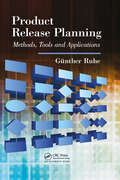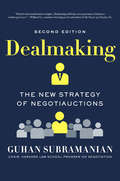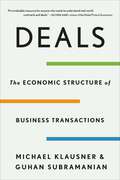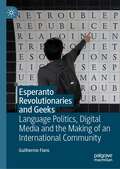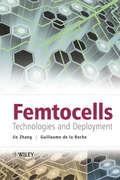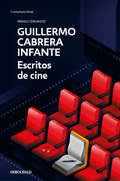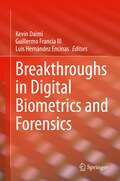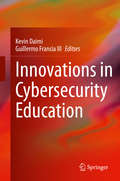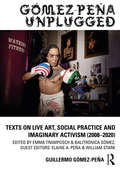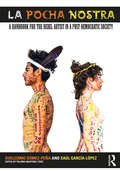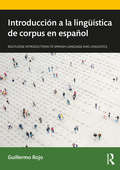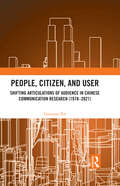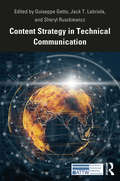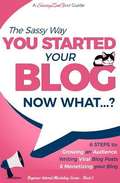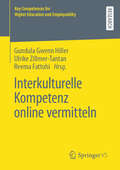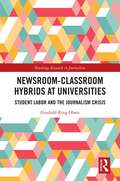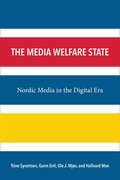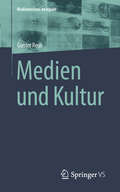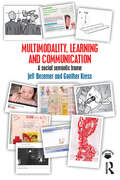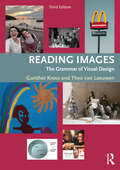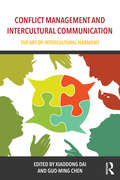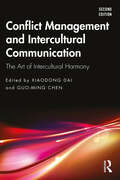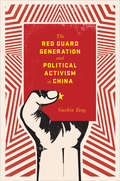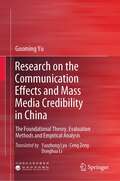- Table View
- List View
Product Release Planning: Methods, Tools and Applications
by Guenther RuheBusiness success hinges on successfully creating products with the right features. You must correctly analyze the needs of the customer and match these needs with your resources to not only produce a product and but also deliver it in a timely manner. An in-depth understanding of systematic release planning can put you on this path. Authored by ren
Dealmaking (Second Edition): The New Strategy Of Negotiauctions
by Guhan SubramanianBased on broad research and detailed case studies, Dealmaking provides the jargon-free, empirically sound advice you need to close the deal. Leading dealmaking scholar Guhan Subramanian specializes in understanding how deals work. As a Harvard Business School professor, he has spent years examining and teaching corporate dealmaking through two classic lenses: negotiation theory and auction theory. As he looked at real-world situations, however, he discovered that complex deals usually combine both approaches: negotiators are "fighting on two fronts"—across the table and on the same side—with known, unknown, or potential competitors. In Dealmaking, Subramanian provides classroom-tested examples of "negotiauctions" as diverse as buying a house, haggling over the rights to the television show Frasier, or selling "toxic" assets into the U.S. government’s bailout fund. With each scenario, he identifies the specific moves that ensure success. The first book to bring together auction and negotiation strategies in a meaningful way, Dealmaking is an indispensable guide to negotiating deals in the twenty-first century.
Deals: The Economic Structure of Business Transactions
by Guhan Subramanian Michael KlausnerDrawing on real-life cases from a wide range of industries, two acclaimed experts offer a sophisticated but accessible guide to business deals, designed to maximize value for your side.Business transactions take widely varying forms—from multibillion-dollar corporate mergers to patent licenses to the signing of an all-star quarterback. Yet every deal shares the same goal, or at least should: to maximize the joint value created and to distribute that value among the parties. Building on decades of experience teaching and advising on business deals, Michael Klausner and Guhan Subramanian show how to accomplish this goal through rigorous attention to designing incentives, conveying information, and specifying parties’ rights and obligations.Deals captures the range of real-life transactional complexities with case studies covering Microsoft’s acquisition of LinkedIn, Scarlett Johansson’s contract dispute with Disney over the release of Black Widow, litigation surrounding LVMH’s pandemic-disrupted acquisition of Tiffany, the feud between George Norcross and Lewis Katz over ownership of the Philadelphia Inquirer, NBC/Viacom’s negotiation with Paramount over the final three seasons of Frasier, and many more. In clear, concise terms, Klausner and Subramanian establish the basic framework of negotiation and the economic concepts that must be addressed in order to maximize value. They show how to tackle challenges, such as information asymmetry between buyer and seller, moral hazard, and opportunistic behavior. And the authors lay out responses to common risks associated with long-term contracts, emphasizing that a deal’s exit rights should be carefully considered at the start of transaction design.Unique in its practical application of economic theory to actual dealmaking, this book will be an indispensable resource for students and for professionals across the business and legal world.
Esperanto Revolutionaries and Geeks: Language Politics, Digital Media and the Making of an International Community
by Guilherme FiansThis book explores how Esperanto – often regarded as a future-oriented utopian project that ended up confined to the past – persists in the present. Constructed in the late nineteenth century to promote global linguistic understanding, this language was historically linked to anarchism, communism and pacifism. Yet, what political relevance does Esperanto retain in the present? What impacts have emerging communication technologies had on the dynamics of this speech community? Unpacking how Esperanto speakers are everywhere, but concentrated nowhere, the author argues that digital media have provided tools for people to (re)politicise acts of communication, produce horizontal learning spaces and, ultimately, build an international community. As Esperanto speakers question the post-political consensus about communication rights, this language becomes an ally of activism for open-source software and global social justice. This book will be of relevance to students and scholars researching political activism, language use and community-building, as well as anyone with an interest in digital media more broadly.
Femtocells
by Guillaume De La Roche Jie ZhangThis book provides an in-depth guide to femtocell technologiesIn this book, the authors provide a comprehensive and organized explanation of the femtocell concepts, architecture, air interface technologies, and challenging issues arising from the deployment of femtocells, such as interference, mobility management and self-organization. The book details a system level simulation based methodology addressing the key concerns of femtocell deployment such as interference between femto and macrocells, and the performance of both femto and macrocell layers. In addition, key research topics in interference modeling and mitigation, mobility management and Self-Organizing Network (SON) are highlighted. The authors also introduce HNB/HeNB standardization in 3GPP.. Furthermore, access methods (closed, open and hybrid), applications, timing synchronization, health issues, business models and security are discussed. The authors also provide a comparison between femtocells and other indoor coverage techniques such as picocells, repeaters, distributed antenna systems and radio over fiber. Lastly, both CDMA and OFDMA based femtocells are covered.Key Features:Provides a comprehensive reference on femtocells and related topics Offers the latest research results on femtocells based on simulation and measurements Gives an overview of indoor coverage techniques such as picocells, repeaters, distributed antenna systems, radio over fiber and femtocells Includes chapters on femtocell access network architecture, air interface technologies (GSM, UMTS, HSPA, WiMAX and LTE), femtocell simulation, interference analysis and mitigation in femto/macrocell networks, mobility management in femto/macrocell networks, femtocell self-organization and other key challenges such as timing synchronization and security faced by femtocell deployment Points to over 240 references from 3GPP, The Femto Forum, journals and conference proceedings This book will be an invaluable guide for RF engineers from operators, R&D engineers from femtocells hardware manufacturers, employees from regulatory bodies, radio network planners, academics and researchers from universities and research organizations. Students undertaking wireless communications courses will also find this book insightful.
Escritos de cine (estuche: Un oficio del siglo xx, Arcadia todas las noches, Cine o Sardina)
by Guillermo Cabrera InfanteLas tres colecciones de artículos sobre cine de Guillermo Cabrera Infante en un estuche que se disfruta como una función. Director de la cinemateca de Cuba y crítico de cine en su juventud, guionista de Hollywood en su madurez, Guillermo Cabrera Infante fue un apasionado cinéfilo toda su vida. El presente estuche reúne sus tres colecciones de ensayos sobre el tema: Un oficio del siglo xx, Arcadia todas las noches y Cine o sardina. En ellas brillan su espíritu lúdico y la fina ironía, que nos ayudan a comprender el sentido, el contexto y la factura del séptimo arte. De texto en texto y de mirada en mirada, Cabrera Infante repasa la obra de Orson Welles, Alfred Hitchcock, Howard Hawks, John Huston o Vincente Minnelli, así como una plétora de películas clásicas y modernas. Si el cine es el protagonista indiscutible, el crítico-escritor no deja de darle la réplica. Del diálogo entre la pantalla y la palabra surgen textos que no solo aportan una valiosa información, sino que se disfrutan como verdaderas funciones. Sobre el autor y la obra:«Para los que estudiábamos cine, Un oficio del siglo XX era un libro de cabecera.»Fernando Trueba «Ha convertido la crítica cinematográfica en un género literario gracias a su riqueza verbal y a su imaginación.»Mario Vargas Llosa «Cabrera Infante es casi una enciclopedia del cine hollywoodense.»Jacobo Machover, Revista de Libros
O / Exorcismos de esti(l)o
by Guillermo Cabrera InfanteDos libros experimentales reunidos en un volumen en el que brilla el inigualable talento lúdico de Guillermo Cabrera Infante En este volumen conviven dos libros próximos en el tiempo de Guillermo Cabrera Infante: la colección de artículos y ensayos O, publicada originalmente en 1975, y el libro de piezas experimentales Exorcismos de esti(l)o, aparecido en 1976. En el primero, el autor despliega su peculiar ingenio creador, en ocasiones satírico y burlón, para describir facetas de su cotidianidad y de la vida contemporánea, haciendo referencia a protagonistas tan diversos como su inigualable gato Offenbach y los miembros de la policía secreta. En Exorcismos, una colección repleta de saber clásico y sarcásticas investigaciones literarias, brilla el talento lúdico del Cabrera Infante, así como su obsesión por las sorpresas del lenguaje, plasmada en una serie de retruécanos, juegos de palabras multilingües e ingeniosas manipulaciones tipográficas que evocan a e.e. cummings y al OuLiPo. La crítica ha dicho:«Guillermo Cabrera Infante era un grandísimo escritor.»Mario Vargas Llosa «Uno de los mayores y mejores renovadores de la prosa en castellano, un clásico de vanguardia.»Fernando Savater «Su talento verbal era extraordinario, tanto de viva voz como por escrito, aunque esto último lo sepa cualquiera que haya leído sus libros.»Javier Marías «Cabrera Infante trajo al sector desarraigado a la fuerza de Cuba las virtudes de la parodia, la sátira y el humor.»José Miguel Oviedo, Letras Libres
Breakthroughs in Digital Biometrics and Forensics
by Luis Hernández Encinas Kevin Daimi Guillermo FranciaThis book focuses on a wide range of breakthroughs related to digital biometrics and forensics. The authors introduce the concepts, techniques, methods, approaches and trends needed by cybersecurity specialists and educators for keeping current their biometrics and forensics knowledge. Furthermore, the book provides a glimpse of future directions where biometrics and forensics techniques, policies, applications, and theories are headed. Topics include multimodal biometrics, soft biometrics, mobile biometrics, vehicle biometrics, vehicle forensics, integrity verification of digital content, people identification, biometric-based cybercrime investigation, among others. The book is a rich collection of carefully selected and reviewed manuscripts written by diverse digital biometrics and forensics experts in the listed fields and edited by prominent biometrics and forensics researchers and specialists.
Innovations in Cybersecurity Education
by Kevin Daimi Guillermo Francia IIIThis book focuses on a wide range of innovations related to Cybersecurity Education which include: curriculum development, faculty and professional development, laboratory enhancements, community outreach, and student learning. The book includes topics such as: Network Security, Biometric Security, Data Security, Operating Systems Security, Security Countermeasures, Database Security, Cloud Computing Security, Industrial Control and Embedded Systems Security, Cryptography, and Hardware and Supply Chain Security. The book introduces the concepts, techniques, methods, approaches and trends needed by cybersecurity specialists and educators for keeping current their security knowledge. Further, it provides a glimpse of future directions where cybersecurity techniques, policies, applications, and theories are headed. The book is a rich collection of carefully selected and reviewed manuscripts written by diverse cybersecurity experts in the listed fields and edited by prominent cybersecurity researchers and specialists.
Gómez-Peña Unplugged: Texts on Live Art, Social Practice and Imaginary Activism (2008–2020)
by Guillermo Gómez-PeñaGómez-Peña Unplugged is an anthology of recent and rewritten classic writings from Guillermo Gómez-Peña, a figure who stands alone as unique and ground-breaking in the history of performance art and as the artistic director of transdisciplinary performance troupe La Pocha Nostra. Throughout this collection, Gómez-Peña tackles literature, theory, pedagogy, activism and live art in an eclectic mix that demonstrates how the process of writing is simultaneously a performative exercise in embodied language. The writing stands as a call for action, utilizing what Gómez-Peña terms “imaginary activism” and “radical citizenship”; it invites the reader to embrace a borderless, polygendered, crossgenerational and race-literate ethos. This timely anthology comes straight from the heart of a troubled Trump-era United States and a crime cartel–ridden Mexico. Artists and writers are prompted to engage in radical performance pedagogy within the civic realm and to think of themselves as public intellectuals and “artivists” participating in the great debates of our times. By encouraging emerging artists and writers to wildly imagine their practice beyond the normative art world and academia, this book is a fundamental read for scholars and students of performance art, political theatre, cultural studies, literature, poetry, activism and race and gender politics. Performance Art, Live or Time-Based Art, Cultural Studies, Experimental Poetry, Multiculturalism, Social Practice, Chicano/Latino/Border Art & Literature, Relational Aesthetics, Public Art, Artivism, Activism, Psychomagic Ritual, Literary Studies, Anthropology, Sociology, Ethnic & Gender Studies, Queer & Women Studies, Post-Colonial Theory, Techno-Art, Cyborgian Studies, Exoticized & Fetishized Identities, Deconstruction Stereotypes & Binaries, Anti-Essentialism, Anti-Nationalism, Radical Citizenship, Anti-Racism, Race & Gender Literacy
La Pocha Nostra: A Handbook for the Rebel Artist in a Post-Democratic Society
by Guillermo Gómez-Peña Saúl García-LópezLa Pocha Nostra: A Handbook for the Rebel Artist in a Post-Democratic Society marks a transformation from its sister book, Exercises for Rebel Artists, into a pedagogical matrix suited for use as a performance handbook and conceptual tool for artists, activists, theorists, pedagogues, and trans-disciplinary border crossers of all stripes. Featuring a newly reworked outline of La Pocha Nostra's overall pedagogy, and how it has evolved in the time of Trump, cartel violence, and the politics of social media, this new handbook presents deeper explanations of the interdisciplinary pedagogical practices developed by the group that has been labeled "the most influential Latino/a performance troupe of the past ten years." Co-written by Guillermo Gómez-Peña in collaboration with La Pocha Nostra’s artistic co-director Saúl García-López and edited by Paloma Martinez-Cruz, this highly anticipated follow-up volume raises crucial questions in the new neo-nationalist era. Drawing on field experience from ten years of touring, the authors blend original methods with updated and revised exercises, providing new material for teachers, universities, radical artists, curators, producers, and students. This book features: Introductions by the authors and editor to Pocha Nostra practice in a post-democratic society. Theoretical, historical, poetic, and pedagogical contexts for the methodology. Suggestions for how to use the book in the classroom and many other scenarios. Detailed, hands-on exercises for using Pocha Nostra-inspired methods in workshops. A step-by-step guide to creating large-scale group performances. New, unpublished photos of the Pocha Nostra methods in practice. Additional texts by Reverend Billy and Savitri D., Dragonfly, Francesca Carol Rolla, VestAndPage, Micha Espinosa, Zulfikar Ali Bhutto, Praba Pilar, L. M. Bogad, Anuradha Vikram, and Annie Sprinkle and Beth Stephens, among many others. The book is complemented by the new book Gómez-Peña Unplugged: Texts on Live Art, Social Practice and Imaginary Activism (2008–2019).
Introducción a la lingüística de corpus en español
by Guillermo RojoIntroducción a la lingüística de corpus en español es la primera obra concebida desde la óptica del español para investigar los corpus textuales existentes en la actualidad. Destinada a conjugar armónicamente la exposición de cuestiones teóricas y metodológicas, proporciona información detallada sobre las tareas necesarias en el diseño, construcción y explotación de un corpus a partir de numerosos ejemplos de obtención de datos sobre diferentes cuestiones léxicas y gramaticales. Características principales: • Exposición de cuestiones teóricas y metodológicas combinada con el tratamiento de casos prácticos de extracción y análisis de datos procedentes de corpus textuales de español; • Análisis de fenómenos léxicos y gramaticales del español desde diferentes perspectivas y con atención a la variabilidad diacrónica, diatópica y diastrática; • Indicación detallada del modo de obtener los datos necesarios para la investigación en diferentes corpus del español; • Inclusión de un resumen inicial, actividades de investigación en cada capítulo y lecturas complementarias recomendadas; • Presentación de un capítulo final con herramientas informáticas útiles para el análisis de textos no incluidos en corpus textuales; • Recopilación de los principales términos usados en la lingüística de corpus en un glosario bilingüe (español e inglés). Introducción a la lingüística de corpus en español es una obra con un enfoque marcadamente didáctico, y dirigida fundamentalmente a estudiantes avanzados de grado y posgrado, profesores que necesiten hacer uso de corpus en sus clases, investigadores que precisen un conocimiento más profundo de la lingüística de corpus o expertos en otras disciplinas que deseen familiarizarse con una perspectiva técnica de los fenómenos lingüísticos.
People, Citizen, and User: Shifting Articulations of Audience in Chinese Communication Research (1978 – 2021)
by Guiquan XuThe book examines the changing discourses of Chinese audience research in the past four decades, aiming to shed light on the complicated relationships among China’s media, audiences, and society. With the new sociology of knowledge, it adopts Laclau and Mouffe’s discourse theory as a meta-theoretical framework and interprets the concept of audience as a floating signifier. Based on the corpus of Chinese academic journal papers, the author divides the scope of analysis into four phases. In each period, Chinese audience research was related closely to the changing societal and academic contexts and hegemonic struggle as a whole. In addition, it discusses the relation between ‘western’ audience theories and Chinese audience research, as well as the contingency and rigidity of discourses in Chinese audience research. The book contributes to the understanding of Chinese communication research in the changing societal context and will be valuable for scholars of media and communication studies or China studies.
Content Strategy in Technical Communication: A How-to Guide (ATTW Series in Technical and Professional Communication)
by Guiseppe Getto Jack T. Labriola Sheryl RuszkiewiczContent Strategy in Technical Communication provides a balanced, comprehensive overview of the current state of content strategy within the field of technical communication while showcasing groundbreaking work in the field. Emerging technologies such as content management systems, social media platforms, open source information architectures, and application programming interfaces provide new opportunities for the creation, publication, and delivery of content. Technical communicators are now sometimes responsible for such diverse roles as content management, content auditing, and search engine optimization. At the same time, we are seeing remarkable growth in jobs devoted to these other content-centric skills. This book provides a roadmap including best practices, pedagogies for teaching, and implications for research in these areas. It covers elements of content strategy as diverse as "Editing Content for Global Reuse" and "Teaching Content Strategy to Graduate Students with Real Clients," while giving equal weight to professional best practices and to pedagogy for content strategy. This book is an essential resource for professionals, students, and scholars throughout the field of technical communication.
You Started Your Blog: Now What...?
by Gundi Gabrielle<p>PLEASE NOTE: This book is written for COMPLETE BEGINNERS. <p>Those that have just set up their first blog and are now struggling with the next steps and where to go from here. It was written in response to feedback I received from my first book, which teaches the technical set up to complete beginners. I noticed patterns of what people were struggling with - often just even deciding what topic to focus on - and how blogging works in general. <p>This book will take you by the hand and guide you through the next steps - the solid, basic techniques that every successful blogger started with. There is no magic pill to suddenly attract thousands of followers - although there are a few techniques that can speed things up and we will cover them. Another area that is often underestimated is learning the WRITING STYLE OF BLOGGING, including how to format your posts.T his book goes into detail and provides resources for further training as that is obviously not something you will learn overnight. <p>We will also look at the characteristics of Viral blog posts, but - once again - don't expect a magic pill! Blogging is hard work and becoming a good blogger - a good blog writer - takes training and time, even if you are already experienced in writing. People read blogs differently than books and unless you adjust to that, you will have a hard time attracting an audience - no matter how experienced a writer you are. Finally, we wil go over the basic monetization strategies that are available to bloggers. <p>If you are new to blogging and are willing to put in the necessary work - and do so consistently - this book will give you a good basic start and take out much of the confusion new bloggers face. Of course, blogging also involves the powerful marketing techniques of SEO and Social Media and they are discussed in depth in part 3 and 4 of this series. I have personally found Kindle Publishing to be another great way to grow a blog following quickly - faster than any other technique actually - and so it is included as part 5 of this series. <p>Once again - if you are looking for advanced techniques, this book will not be for you - it is specifically aimed at beginners who have just started their first blog.</p>
Interkulturelle Kompetenz online vermitteln (Key Competences for Higher Education and Employability)
by Gundula Gwenn Hiller Ulrike Zillmer-Tantan Reema FattohiBei interkulturellen Trainings geht es um den Erwerb des kommunikativen Handlungswissens sowie die Arbeit an der inneren Haltung. Voraussetzungen dafür sind eine vertrauensvolle Atmosphäre und Interaktion. Wie lässt sich das online umsetzen? Dieses Buch liefert darauf Antworten, in 3 Teilen:• Theoretische Grundlagen vermitteln didaktische Prinzipen • Praxisberichte inspirieren zur Umsetzung innovativer Lehr-Lernkonzepte, und • Eine praxiserprobte Methoden-Sammlung von über 50 Trainer*innen liefert eine breite Auswahl an Tools für interkulturelles Lernen. Trainer*innen und Lehrende finden hier solides handwerkliches Wissen mit konkreten Umsetzungstipps.
Newsroom-Classroom Hybrids at Universities: Student Labor and the Journalism Crisis (Routledge Research in Journalism)
by Gunhild Ring OlsenThis book investigates the success of U.S. nonprofit university centers, where students work alongside investigative reporters, from a professional and educational perspective. Drawing on a detailed investigation of four of the most prominent and renowned centers in the U.S. – the IRP Berkeley (UC Berkeley), the Stabile Center (Columbia University), the Workshop (American University), and the New England CIR (Boston University) – the newsroom role and the classroom role of university nonprofits is examined. Finding the description of a win-win situation – where overstretched newsrooms get extra resources; while students learn from the best – an oversimplification, the author explores learning outcomes, student experiences, financial benefits, and quality of the student output. Offering an in-depth analysis of the characteristics, challenges and benefits of different forms of journalistic cooperation, this book will be a useful resource to scholars, students and practitioners of journalism, journalism education, and media practice.
The Media Welfare State: Nordic Media In The Digital Era
by Ole J. Mjøs Hallvard Moe Trine Syvertsen Gunn Sara EnliThe Media Welfare State: Nordic Media in the Digital Era comprehensively addresses the central dynamics of the digitalization of the media industry in the Nordic countries--Sweden, Norway, Denmark, Finland, and Iceland--and the ways media organizations there are transforming to address the new digital environment. Taking a comparative approach, the authors provide an overview of media institutions, content, use, and policy throughout the region, focusing on the impact of information and communication technology/internet and digitalization on the Nordic media sector. Illustrating the shifting media landscape the authors draw on a wide range of cases, including developments in the press, television, the public service media institutions, and telecommunication.
Medien und Kultur (Medienwissen kompakt)
by Gunter ReusMedien bestimmen unseren Alltag in jeder Lebenslage. Viele Menschen empfinden ihre Macht aber als gefährlich für die gesellschaftliche Kultur. Gunter Reus zeigt dagegen, wie sehr ein Gemeinwesen auf der kulturellen Leistung der Massenmedien aufbaut. Der Autor bedient sich dabei eines weiten Kulturbegriffs und zeichnet nach, wie sie Errungenschaften der Menschheit historisch ausgeformt haben. Ohne Medien gäbe es keine einheitliche Sprache und keinen Austausch von Information und Wissen, wie wir ihn kennen. Es gäbe keine Ausbalancierung sozialer Interessen, keine Kontrolle von Macht, keine Orientierung auf das Gemeinwohl, kein Kunstleben. Auch im Internetzeitalter bleiben Massenmedien, bei aller notwendigen Kritik an ihren Schattenseiten, unverzichtbar als Kulturträger. Sie sorgen für die Transparenz politischen Handelns ebenso wie für die (potentielle) Teilhabe aller am Kunstgeschehen. Damit prägen sie die Kultur der Demokratie wie auch die Kultur in der Demokratie entscheidend mit.
Multimodality, Learning and Communication: A social semiotic frame
by Gunther Kress Jeff BezemerThis state-of-the-art account of research and theorizing brings together multimodality, learning and communication through detailed analyses of signmakers and their meaning-making in museums, hospitals, schools and the home environment. By analyzing video recordings, photographs, screenshots and print materials, Jeff Bezemer and Gunther Kress go well beyond the comfortable domains of traditional sites of (social) semiotic and multimodal research. They steer away from spurious invention and naming of ever more new and exciting domains, focusing instead on fundamentals in assembling a set of tools for current tasks: namely, describing and analyzing learning and communication in the contemporary world as one integrated field. The theory outlined in the book is grounded in the findings of the authors' wide-ranging empirical investigations. Each chapter evaluates the work that is being done and has been done, challenging accepted wisdom and standing much of it on its head. With extensive illustrations and many examples presented to show the reach and applicability of the theory, this book is essential reading for all those working in multimodality, semiotics, applied linguistics and related areas. Images from the book are also available to view online at www.routledge.com/9780415709620/
Reading Images: The Grammar of Visual Design
by Gunther Kress Theo van LeeuwenThis third edition of the landmark textbook Reading Images builds on its reputation as the first systematic and comprehensive account of the grammar of visual design. Drawing on an enormous range of examples from children's drawings to textbook illustrations, photo-journalism to fine art, as well as three-dimensional forms such as sculpture and toys, the authors examine the ways in which images communicate meaning. Features of this fully updated third edition include: new material on diagrams and data visualization a new approach to the theory of 'modality' a discussion of how images and their uses have changed since the first edition examples from a wide range of digital media including websites, social media, I-phone interfaces and computer games ideas on the future of visual communication. Reading Images presents a detailed outline of the 'grammar' of visual design and provides the reader with an invaluable 'tool-kit' for reading images in their contemporary multimodal settings. A must for students and scholars of communication, linguistics, design studies, media studies and the arts.
Conflict Management and Intercultural Communication: The Art of Intercultural Harmony
by Guo-Ming Chen Xiaodong DaiIn the globally interconnected world, conflicts often arise as a result of tensions between different cultural perceptions and diverse social preferences. Effectively managing conflicts and harmonizing intercultural relationships are essential tasks of intercultural communication research. This book seeks to find effective intercultural conflict management solutions by bringing together a group of leading international scholars from different disciplines to tackle the problem. Consisting of two parts, this book covers major theoretical perspectives of conflict management and harmony development in the first and conflict management and harmony development in different cultural contexts in the second. Integrating the latest work on conflict management and intercultural harmony, Conflict Management and Intercultural Communication takes an interdisciplinary approach, adopts diverse perspectives, and provides for a wide range of discussions. It will serve as a useful resource for teachers, researchers, students and professionals alike.
Conflict Management and Intercultural Communication: The Art of Intercultural Harmony
by Guo-Ming Chen Xiaodong DaiConflict management and harmony building are two key issues of intercultural communication research and merit particular attention in the globally interconnected world. In the expanded second edition, the book explores the effective ways to manage intercultural conflict and develop intercultural harmony, and takes an interdisciplinary approach to address the two issues. The book begins with the theoretical perspectives on conflict management and harmony building. It examines intercultural communication ethics, diversity and inclusion, conflict resolution, conflict face negotiation, and intercultural competence. It presents both Western and non-Western perspectives. The book then addresses in its second section conflict management and harmony building in specific contexts. These include communication in intergenerational relationships, multinational corporations, and virtual spaces, and covers a range of national cultures including the USA, Japan, Germany, and China. Drawing on the current research findings, this book covers the major theoretical perspectives and provides for a wide range of discussions on intercultural conflict management. It is a crucial reference for teachers, students, researchers, and practitioners alike.
The Red Guard Generation and Political Activism in China (Studies of the Weatherhead East Asian Institute, Columbia University)
by Guobin YangRaised to be "flowers of the nation," the first generation born after the founding of the People's Republic of China was united in its political outlook and at first embraced the Cultural Revolution of 1966, but then split into warring factions. Investigating the causes of this fracture, Guobin Yang argues that Chinese youth engaged in an imaginary revolution from 1966 to 1968, enacting a political mythology that encouraged violence as a way to prove one's revolutionary credentials. This same competitive dynamic would later turn the Red Guard against the communist government.Throughout the 1970s, the majority of Red Guard youth were sent to work in rural villages, where they developed an appreciation for the values of ordinary life. From this experience, an underground cultural movement was born. Rejecting idolatry, these relocated revolutionaries developed a new form of resistance that signaled a new era of enlightenment, culminating in the Democracy Wall movement of the late 1970s and the Tiananmen protest of 1989. Yang's final chapter on the politics of history and memory argues that contemporary memories of the Cultural Revolution are factionalized along these lines of political division, formed fifty years before.
Research on the Communication Effects and Mass Media Credibility in China: The Foundational Theory, Evaluation Methods and Empirical Analysis
by Guoming YuThis book establishes a measurement index to quantify China’s mass media public credibility, based on extensive research and the encapsulation of measurement theories and approaches related to media public credibility, as well as numerous empirical case studies from the international academic community over the past hundred years. The investigation into the current state of Chinese mass media public credibility and discussion on practical approaches to enhancing such public credibility is highly significant in the context of research on media public credibility. The book focuses on two fundamental issues: i) investigating the basic factors the Chinese audience values as the yardstick for media credibility, and ii) formulating a media public credibility measurement scale. Relying on data from investigations, the authors analyze the importance of various assessment benchmarks for measuring media public credibility and the characteristics of public credibility assessment. Lastly, a measurement scale is created by screening and analyzing measurement indices with statistical methods such as exploratory and authenticated factor analyses and credibility and validity testing, which is of high theoretical and practical scientific value.
